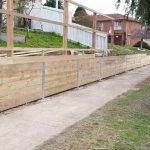Introduction
Building a retaining wall isn't almost stacking stones or pouring concrete; it's an intricate procedure steeped in science and engineering. Retaining walls are important structures that hold back soil, avoiding erosion and enabling the production of functional arrive at slopes. Whether you're aiming to install a garden feature, create more area for landscaping, or avoid soil motion in locations vulnerable to shifts, understanding the intricacies behind strong and durable retaining walls is vital. This short article will explore different elements of retaining walls, providing insights from professional contractors who specialize in this field.
The Science Behind Strong and Resilient Retaining Walls by Professional Contractors
When we speak about the science behind keeping walls, we're diving deep into materials, design concepts, and structural stability. Keeping walls can be made from different materials such as concrete sleepers, timber sleepers, stone, and even H beams. Each product offers special advantages and obstacles that need to be understood for optimum performance.

Understanding Soil Mechanics
Soil mechanics is the foundation of any keeping wall construction. The wall must hold up against the lateral pressure applied by the soil it holds back. This pressure differs based on a number of elements:
- Soil type: Clay, sand, silt-- all these types act differently under stress. Moisture content: Water increases soil weight and can trigger instability. Height of the wall: Taller walls require more robust support mechanisms.
The Function of Drain in Maintaining Walls
One key aspect often overlooked is drain. Water accumulation behind a wall can lead to increased pressure that might jeopardize its stability.
Weep holes: These permit water to escape. Drainage pipes: Set up at the base to channel water away. Gravel backfill: Promotes drain while supplying stability.Types of Retaining Walls
Understanding various kinds of maintaining walls is vital for choosing the ideal one for your project.
Gravity Walls
Gravity walls count on their own weight to resist soil pressure. They are normally made from heavy materials like stone or concrete.
Pros & Cons
- Pros: Basic style; no special foundation needed. Cons: Limited height; requires considerable space at the base.
Cantilevered Walls
These walls use take advantage of to hold back soil, including a horizontal piece that extends into the kept soil.
Pros & Cons
- Pros: More efficient than gravity walls for taller heights; less material needed. Cons: Needs careful engineering and style calculations.
Sheet Stack Walls
Often used in soft soils where other types may stop working, sheet pile walls consist of interlocking slabs driven into the ground.
Pros & Cons
- Pros: Reliable in tight spaces; very little footprint. Cons: Less stable under high loads; can be expensive.
Choosing Products for Maintaining Walls
The option of materials significantly affects a wall's sturdiness and effectiveness.
Concrete Sleepers vs Timber Sleepers
Concrete sleepers are preferred for their strength and durability compared to wood sleepers which are more aesthetically pleasing however might have a shorter life-span due to rot or insect damage.
Comparison Table
|Product|Resilience|Expense|Aesthetic Appeal|Upkeep|| -------------------|------------|----------|-------------------|--------------|| Concrete Sleepers|High|Medium|Low|Low|| Lumber Sleepers|Medium|Low|High|High|
Stone as a Product Choice
Stone is another classic alternative known for its sturdiness however comes with greater costs connected with labor-intensive installation processes.
Design Considerations by Professional Contractors
Expert professionals know that style plays a critical role in ensuring that keeping walls operate efficiently gradually.
Height Restrictions
Local building codes often impose restrictions on how high a maintaining wall can be developed without requiring extra engineering certification.
Bending Minutes and Shear Forces
Contractors calculate flexing minutes (the propensity of an object to bend) and shear forces (the force acting parallel to an item) when creating keeping walls.
Installation Process Overview
The setup procedure requires careful preparation and execution:
Site assessment Design finalization Material selection Excavation Foundation preparation Wall assemblyCommon Installation Mistakes
It's simple to make mistakes throughout setup-- here are some common ones:
- Not accounting for drainage Skipping proper compaction of backfill Insufficient reinforcement
FAQ Section
What Are Retaining Wall Installers?
Retaining wall installers are specialized professionals who focus solely on building these structures with expertise in various products like concrete sleepers or timber sleepers.
How Long Do Keeping Walls Last?
With appropriate installation and upkeep, a lot of retaining walls can last anywhere from 20 to 100 years depending upon materials used.
Can I Build My Own Retaining Wall?
While DIY tasks can be rewarding, it's advisable to seek advice from a professional specialist if you're unskilled with structural work; improper installation can lead to costly failures down the line.
What Is Backfill?
Backfill describes the material used to fill out behind a keeping wall after building and construction; it generally consists of gravel or crushed stone for ideal drainage.
How Much Does It Cost To Build A Keeping Wall?
Costs differ commonly based on size, product choice (like concrete versus wood sleeper), labor rates, and location but usually variety from $15-$50 per square foot installed.
Are There Allows Required For Structure A Keeping Wall?
Yes! Many towns need permits before constructing any substantial structure like a keeping wall due to security regulations-- constantly examine local laws first!
Conclusion
Building strong and resilient keeping walls includes much more than simply stacking products together-- it's a detailed blend of science, engineering principles, product selection, design factors to consider, ecological aspects like wetness levels or soil types being taken into consideration every action along the method! Whether you select concrete sleepers due to their effectiveness or choose rustic beauty with timber sleepers-- partnering up with knowledgeable experts guarantees success through thorough preparation integrated with market knowledge customized particularly towards your needs! The science behind strong and durable maintaining walls by professional specialists will not just protect your residential or commercial property however likewise improve its http://angelofence-builderojfj965.lowescouponn.com/the-future-of-landscaping-innovative-solutions-from-melbourne-s-retaining-wall-builders visual appeal while standing tall against time itself!